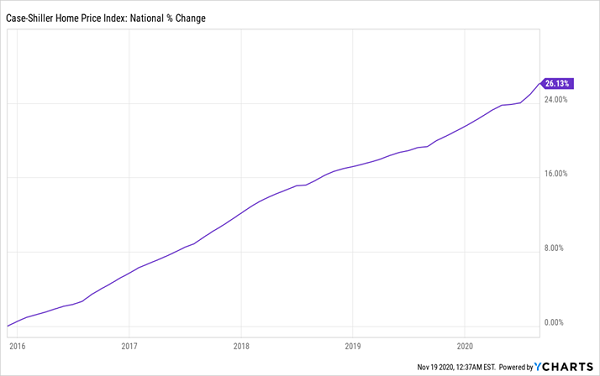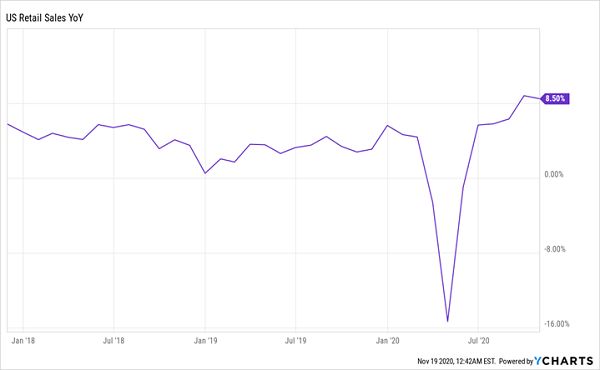Stocks are up—and so are coronavirus cases. And right on cue, I’m hearing from plenty of investors asking if now is the time to sell and lock in their gains.
No way. It’s actually a good time for us contrarians to buy. Here are five reasons why I see stocks rallying into the end of the year—and rolling higher still as we move into 2021.
Market Driver No. 1: Rising House Prices
When house prices rise, homeowners feel wealthier. And when people feel wealthier, they tend to buy stocks.
It’s true that big-city properties are struggling to hold their own, but homes in the suburbs and rural areas are appreciating at a rate we haven’t seen in years. That’s driven strong gains in average prices right across the country:
Rural, Suburban Homes Drive Strong Gains

The upshot: This real estate market is much healthier than what we saw throughout the 2010s, where urban areas and cities saw extreme growth for already-pricey properties, while more affordable homes saw little to no growth. Now that picture has flipped, and it’s bringing much-needed balance to the market.
Market Driver No. 2: Stronger Retail Sales
Partial reopenings across America, as well as consumers’ worries about the virus, stoked fears that post-lockdown spending would stay depressed. So far that hasn’t happened, in part because of the wealth effect created by gains in housing and the stock market.
Retail Sales Rise From Pre-COVID Levels

This is a stunning chart. First, the big dip in early 2020 shows exactly when the shutdown hit the economy.
But more importantly now, we see that the growth rate for retail sales is higher than it was for three years before COVID-19 hit.
How is this possible? It has a lot to do with deferred spending. Americans who weren’t able to spend, or were afraid to, during the start of COVID-19 have adjusted and are spending more comfortably today.
Add in wealth gains due to suburban home-price growth you’ve got a retail sector that’s surprisingly strong—and likely to hold up, despite the rising number of infections.
The upshot: Rising retail sales benefit big companies the most. A lot of this growth is going to Target (TGT), which recently reported one of its best quarters ever, and online leaders Amazon.com (AMZN) and Google (GOOG, GOOGL). It’s also great for companies that have straddled the online and brick-and-mortar worlds, like Costco (COST) and Walmart (WMT). Strong retail sales are better for the stock market than any other part of the economy, which is why this is a good sign that we’ve got a buying opportunity in front of us.
Market Driver No. 3: Stimulus Is Near
Stimulus checks came and went, so we’re seeing the above spending from Americans who aren’t receiving government relief. That’s astounding because unemployment is still at an unprecedented level, and many people are genuinely hurting out there. Both political parties know this, which is why there’s a lot of incentive to get a deal done early in a Biden presidency. Few analysts believe stimulus won’t happen, and it could appear as early as January. For that reason, retail sales could go from strength to an even higher level of strength.
The upshot: More money in consumers’ pockets means more spending, which, in turn, amounts to higher corporate profits. And since inflation is near zero, there’s a lot of room to provide stimulus checks without worrying about stoking prices.
Market Driver No. 4: Farms Are Profitable Again
This is an under-the-radar story, but America’s farmers are seeing higher profits these days.
Thanks to changing consumption habits, demand for US crops has risen. In particular, corn, soybean and other staples are seeing strong demand from China, of all places. Despite tariffs brought in over the last few years, the need to fatten livestock in Asia has driven farmers to buy wheat and corn from America; this has driven the price of a form of wheat used to fatten pigs up 22%, according to data from the Wall Street Journal. Corn prices are rising, too.
Corn Prices Take Off

The upshot: American farmers are a big group that enliven smaller communities across the country. More money in their pockets means more money for nearby towns, and the states in which these farmers live. It also benefits companies selling to those farmers, including dividend growers like Deere & Co. (DE) and Archer Daniels Midland (ADM).
Market Driver No. 5: Vaccines Are Coming
Finally, we now have two vaccines for the virus that have proven to be over 90% effective. The timeline for approval and distribution is uncertain, but Pfizer (PFE) and Moderna (MRNA) are moving toward FDA approval, so vaccines could start being administered in early December.
The upshot: With two (and likely more) vaccines, along with an economic shot in the arm courtesy of (likely) stimulus, we’ll probably see home prices and retail sales keep marching higher, helping lift stocks as they do.
— Michael Foster
5 Huge 8% Dividends That Will Win in 2021 (No Matter What Happens) [sponsor]
With stocks looking strong for the remainder of this year and into 2021, you’re probably wondering what, exactly, you should buy now.
I’ve got you covered there, with 5 closed-end funds (CEFs) paying a rich 8% average dividend between them. Plus, these 5 buys are so cheap they’re primed for 20%+ upside in the coming 12 months as their discounts bubble away—propelling their share prices higher as they do!
In fact, I fully expect even bigger gains than that as the 5 market drivers I just showed you fully kick in!
The best thing about these incredible funds is that their dividends give you a vital margin of safety no matter what happens. Because even if markets take a tumble, you’ll know you have an 8% return—in cash—locked in. And because these funds are so cheap now, their discount valuations will give you an extra “shock absorber” in a pullback, too.
In short, you’re looking at the ultimate “heads you win, tails you win” play here!
These funds are the perfect addition to any investor’s portfolio, and now is the time to buy them. Get all the details on these 5 income gems—names, tickers, best-buy prices and my complete analysis—right here.
Source: Contrarian Outlook

